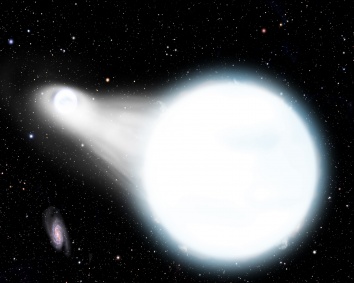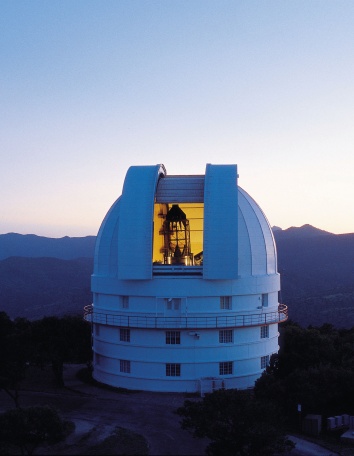Astronomers Discover Stars Locked in Fatalistic Dance
13 July 2011
FORT DAVIS, Texas —Astronomers at The University of Texas at Austin’s McDonald Observatory and the Smithsonian Astrophysical Observatory have discovered a pair of burnt-out stars spiraling into one another at breakneck speeds. Orbiting each other in just 13 minutes, they will merge and possibly explode as a supernova in about 900,000 years. By watching them over time, scientists will test both Einstein’s theory of general relativity and the origin of some peculiar supernovae. This research will be published soon in The Astrophysical Journal Letters.
The two white dwarfs are circling at a bracing speed of 370 miles per second (600 km/s), or 180 times faster than the fastest jet on Earth.
“These stars are whipping around each other so fast they are literally distorting the fabric of space,” said University of Texas at Austin graduate student J. J. Hermes, a member of research team led by Warren Brown of the Smithsonian Institution.
“As J. J. and I watched the first data come in, seeing the eclipses and light variations easily in the raw data, we were elated,” said University of Texas astronomer Don Winget, another team member. “The importance of this object was immediately clear to us.
“This system will give us a chance to test the theory of general relativity in two ways: by detecting the gravitational radiation from this system directly using space missions like LISA and by measuring the rate of the decay of the orbital period as the two objects spiral together."
The brighter white dwarf contains about a quarter of the Sun’s mass compacted into a Neptune-sized ball, while its companion has more than half the mass of the Sun and is Earth-sized. A penny made of this white dwarf’s material would weigh about 1,000 pounds on Earth.
Their mutual gravitational pull is so strong that it deforms the lower-mass star by three percent. If the Earth bulged by the same amount, we would have tides 120 miles high.
The discovery team has been hunting for pairs of white dwarfs using the MMT telescope at Whipple Observatory on Mt. Hopkins, Arizona, and following up with the Otto Struve Telescope at McDonald Observatory. These star pairs are too close together to distinguish photographically. By looking at the spectra, however, they were able to differentiate the two stars and measure their relative motions. These stars are also oriented such that they eclipse each other every 6 minutes.
“If there were aliens living on a planet around this star system, they would see one of their two suns disappear every 6 minutes — a fantastic light show,” said Smithsonian astronomer and team member Mukremin Kilic, who recieved his PhD in astronomy from The University of Texas at Austin several years ago.
These eclipses provide a very accurate clock, which is extremely useful for
measuring any changes in the system.
General relativity predicts that moving objects will create ripples in the fabric of space-time, called gravitational waves. These waves carry away energy, causing the stars to inch closer together and orbit each other faster and faster.
“Though we have not yet directly measured gravitational waves with modern instruments, we can test their existence by measuring the change in the separation of these two stars,” Hermes said. “Because they don’t seem to be exchanging mass, this system is an exceptionally clean laboratory to perform such a test.”
The team expects to conduct this test in a few months, when the star pair emerges from behind the Sun as seen from Earth.
Some models predict merging white dwarf pairs such as these are the source of a rare class of unusually faint stellar explosions called underluminous supernovae.
“If these systems are responsible for underluminous supernovae, we will detect these binary white dwarf systems with the same frequency that we see the supernovae. Our survey isn’t complete, but so far, the numbers agree,” Brown said.
This work will provide an important observational test on theories of white dwarf mergers, which are thought to produce many kinds of supernovae.
Brown’s co-authors are Mukremin Kilic (Harvard-Smithsonian Center for
Astrophysics (CfA)), J. J. Hermes (University of Texas at Austin), Carlos Allende Prieto (Instituto de Astrofisica de Canarias, Spain), Scott J. Kenyon (CfA) and Don Winget (University of Texas at Austin).
Established in 1932, The University of Texas at Austin McDonald Observatory near Fort Davis, Texas, hosts multiple telescopes undertaking a wide range of astronomical research under the darkest night skies of any professional observatory in the continental United States. McDonald is home to the consortium-run Hobby-Eberly Telescope, one of the world's largest, which will soon be upgraded to begin the HET Dark Energy Experiment. An internationally known leader in astronomy education and outreach, McDonald Observatory is also pioneering the next generation of astronomical research as a founding partner of the Giant Magellan Telescope.
— END —
Science Contacts:
J. J. Hermes: 512-471-3466
Dr. Don Winget: 512-471-3404







